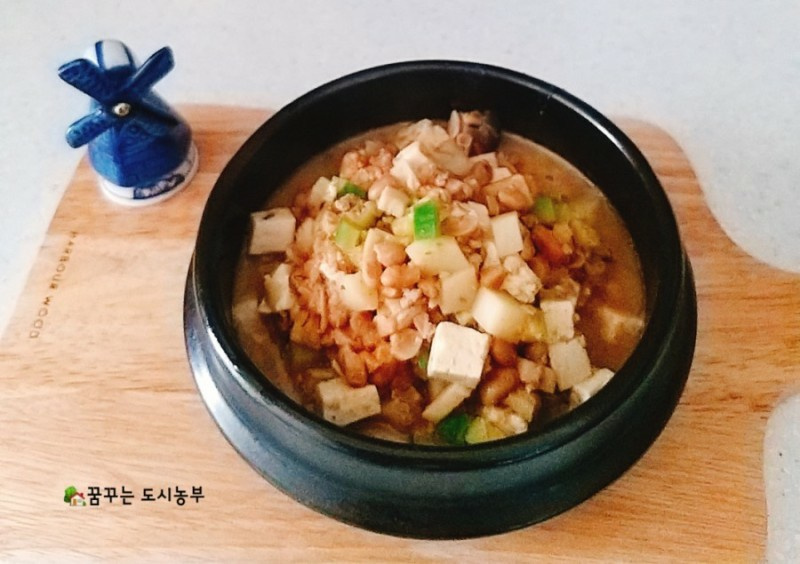Hearty Cheonggukjang (Fermented Soybean Paste Stew)
Recipe for Delicious and Savory Cheonggukjang, a Rice Thief!

This hearty Cheonggukjang is incredibly delicious mixed with a bowl of rice. It’s the perfect partner for your meals, especially when your appetite is a bit low. Discover the golden recipe for this deeply flavorful and healthy fermented soybean paste stew, easily made at home.
Main Ingredients- 240g Cheonggukjang (fermented soybean paste)
- 2 Tbsp perilla oil
- 1/2 large green onion
- 1 Tbsp minced garlic
- 100g pork neck
- 1 potato
- 1/4 zucchini
- 1 king oyster mushroom
- 1/4 block firm tofu
- 1 tsp red pepper powder
- 1 tsp fermented kimchi brine
All-Purpose Broth Ingredients- 1L water
- 80g radish
- 60g onion
- 26g green onion (white parts)
- 12g anchovies (dried, guts and heads removed)
- 20g dried kelp (kombu)
- 1L water
- 80g radish
- 60g onion
- 26g green onion (white parts)
- 12g anchovies (dried, guts and heads removed)
- 20g dried kelp (kombu)
Cooking Instructions
Step 1
First, generously coat the bottom of a pot with 2 tablespoons of perilla oil. The nutty aroma of perilla oil will enhance the stew’s flavor.

Step 2
Add the minced green onion and 1 tablespoon of minced garlic. Stir-fry over medium heat until fragrant to release the aromatic oils from the green onion and garlic. This step is the beginning of the deep flavor of your Cheonggukjang.

Step 3
Next, wash and dice the zucchini, potato, king oyster mushroom, and tofu into small, bite-sized cubes (about 1cm). Cutting the vegetables evenly will ensure they cook at the same rate.

Step 4
Add the minced pork neck to the pot and stir-fry until the color changes. Then, add the potatoes and sauté until they become slightly translucent. Next, add the zucchini and cook until it’s slightly wilted, then add the king oyster mushrooms and stir-fry. Finally, add the tofu and gently mix everything together. Sautéing a variety of vegetables and meat will deepen the overall flavor profile.

Step 5
Once the vegetables are well-sautéed, pour in 2.5 cups (about 500ml) of the prepared all-purpose broth. Bring to a boil over medium heat and simmer until the potatoes are completely cooked through. It’s important to let the broth simmer and infuse into the ingredients.

Step 6
Instead of adding the 240g of Cheonggukjang in a block, crumble it with your hands into smaller pieces before adding it to the pot. This helps it meld better with the stew. If there are still large chunks, gently break them up with a spoon.

Step 7
After adding the Cheonggukjang, sprinkle in 1 teaspoon of red pepper powder. This adds a touch of spiciness to the savory paste, making it even more delicious.

Step 8
Add 1 tablespoon of fermented kimchi brine for a tangy and umami boost. The kimchi brine cuts through the richness of the Cheonggukjang and enhances its overall flavor.

Step 9
Cover the pot and let it simmer over medium-low heat for about 5 minutes, allowing all the ingredients to meld together. Cook until a delightful Cheonggukjang aroma fills your kitchen.

Step 10
And there you have it – your delicious Cheonggukjang is ready! Spoon it over a bowl of hot rice and mix it well for a meal that disappears in no time!

Step 11
Now, let’s learn how to make the all-purpose broth that adds depth to your Cheonggukjang. Start by pouring 1 liter of water into a pot.

Step 12
Add the cleaned radish (80g), onion (60g), and the white parts of the green onion (26g), cut into large pieces, to the water.

Step 13
Reduce the heat to medium-low, cover the pot, and simmer to extract the full flavor from the vegetables.

Step 14
Simmer gently for about 1 hour to draw out the deep essence of the vegetables.

Step 15
After 1 hour, strain the cooked vegetables (radish, onion, green onion) and reserve the clear broth.

Step 16
In a separate pot or cauldron, add the dried anchovies (12g, guts and heads removed) and toast them in a dry pan until fragrant. Roasting the anchovies removes any fishiness and brings out their savory flavor.

Step 17
Roast the anchovies until they are lightly golden and their fishy smell dissipates. Be careful not to burn them.

Step 18
Add the roasted anchovies to the vegetable broth you made earlier. Cover and simmer again.

Step 19
Simmer over medium-low heat for another 15 minutes to allow the deep umami from the anchovies to infuse into the broth.

Step 20
After 15 minutes, remove the roasted anchovies, leaving behind a clear, flavorful anchovy broth.

Step 21
Finally, add the 20g of dried kelp to the clear anchovy broth and simmer for another 15 minutes. The kelp will add a layer of umami and rich flavor to the broth.

Step 22
Once you remove the kelp, your all-purpose broth is complete, with all the flavors harmoniously blended! Use this broth to create even deeper and more delicious Cheonggukjang.



